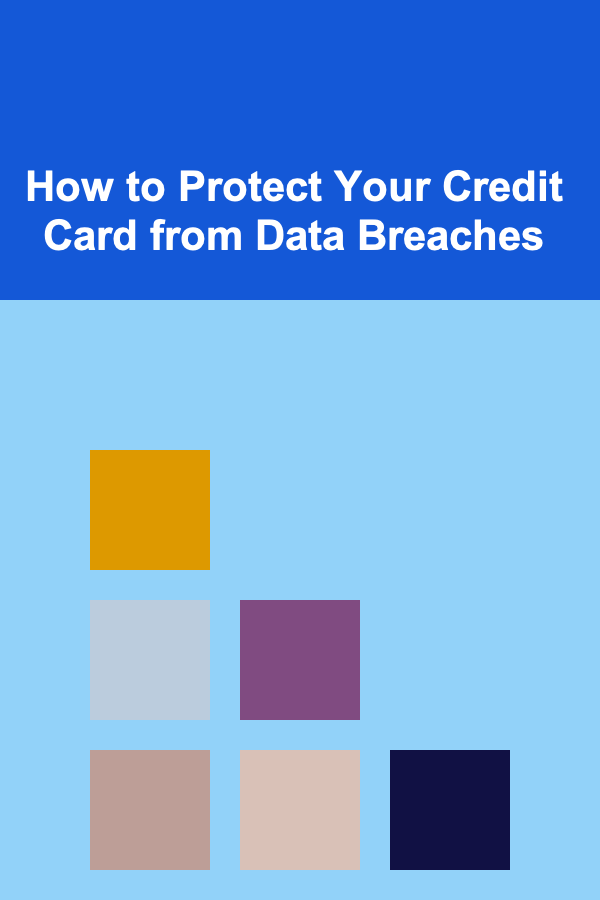
How to Protect Your Credit Card from Data Breaches
ebook include PDF & Audio bundle (Micro Guide)
$12.99$8.99
Limited Time Offer! Order within the next:

Credit card data breaches have become an alarming and pervasive threat in the modern digital world. With the ever-growing volume of online transactions and an increasingly interconnected global marketplace, credit card information is more vulnerable than ever before. Fraudsters exploit weak security systems to gain unauthorized access to sensitive data, and the consequences for consumers can be severe, ranging from financial loss to identity theft.
While it is impossible to completely eliminate the risk of a data breach, there are proactive steps you can take to minimize your exposure and protect your credit card information. This article explores in detail how to protect your credit card from data breaches, focusing on a range of strategies that combine both preventive measures and reactive steps to mitigate damage in the event of a breach.
Understanding Data Breaches and Credit Card Fraud
Before diving into strategies for protection, it's crucial to understand what a data breach is and how it impacts credit card security.
What is a Data Breach?
A data breach occurs when an unauthorized party gains access to sensitive data, often stored in electronic form. This data can include personal information such as names, email addresses, social security numbers, and credit card details. Breaches can happen at a variety of touchpoints, from online shopping websites and payment processors to brick-and-mortar retailers.
In the context of credit cards, data breaches expose your card number, expiration date, security code (CVV), and even your name and billing address. Fraudsters can use this information to make unauthorized transactions, leading to financial losses and potential damage to your credit score.
Types of Credit Card Fraud
- Card Not Present (CNP) Fraud: This type of fraud occurs when your credit card details are stolen and used for online purchases or transactions where physical card verification is not required. This is particularly common in the event of a data breach.
- Card-Not-Received Fraud: If a credit card is stolen in the mail or intercepted, criminals may use the card before the rightful owner even has a chance to activate it.
- Skimming: Skimming occurs when a fraudulent device is placed on ATMs, point-of-sale (POS) terminals, or gas station pumps to collect card information. This type of attack usually targets the physical card rather than the digital transaction data.
- Account Takeover: In this scenario, cybercriminals gain access to your account (often by stealing login details or passwords) and initiate transactions, transferring funds or making purchases.
Proactive Measures to Protect Your Credit Card Information
The most effective way to protect your credit card from data breaches is to take preventative measures. By implementing strong security practices, you can reduce the likelihood of your card details being exposed.
1. Use Strong Passwords and Two-Factor Authentication (2FA)
When shopping online or using digital payment methods, always ensure your accounts are secured with strong, unique passwords. Passwords should combine upper- and lower-case letters, numbers, and special characters. Avoid using easily guessable passwords such as "password123" or personal information like your birthdate.
In addition, enable two-factor authentication (2FA) wherever possible. 2FA adds an extra layer of security by requiring a second verification step---such as a text message or authentication app---when logging in or making purchases. This makes it significantly harder for hackers to gain unauthorized access to your accounts, even if they have your password.
2. Monitor Your Credit Card Statements Regularly
One of the simplest yet most effective ways to catch fraudulent activity early is by regularly reviewing your credit card statements. Look for any charges that you don't recognize or purchases made in locations you haven't visited.
By checking your statements frequently, you can spot suspicious activity before it escalates, and notify your bank or credit card issuer immediately to resolve the issue.
3. Set Up Account Alerts and Notifications
Most credit card companies and banks offer free alert services that notify you of account activity. Set up alerts for various actions, such as transactions, changes in personal information, or unusual spending patterns. These alerts can help you identify fraudulent activity as soon as it happens, enabling you to take immediate action to prevent further damage.
4. Use Virtual Credit Card Numbers
Many banks and credit card issuers offer virtual credit card numbers that you can use for online shopping. These virtual cards are tied to your main account but have a different number, expiration date, and CVV. Since the virtual card number is only valid for a limited time or a single transaction, it minimizes the risk of fraud in case of a data breach.
5. Stick to Trusted Websites and Use Secure Payment Methods
When making online purchases, ensure that the website is trustworthy and uses encryption to protect your data. Look for URLs that start with "https://" and a padlock icon in the browser address bar, which indicate that the site is secure.
Avoid using your primary credit card information on sites you are not familiar with. Instead, consider using payment services like PayPal, Apple Pay, or Google Pay, which offer additional layers of protection between your credit card and the merchant.
6. Enable Transaction Limits
Some credit card issuers allow you to set transaction limits for certain types of purchases or transactions. For example, you can limit how much can be spent on your card in a single transaction or set daily spending limits. These limits can help protect you if your credit card information is stolen and used fraudulently.
7. Use Credit Instead of Debit
While debit cards are convenient, they do not offer the same level of fraud protection as credit cards. If your debit card is compromised, the thief can drain your bank account, potentially leaving you without funds. On the other hand, credit cards offer better fraud protection, with many issuers offering zero liability for unauthorized transactions.
8. Update Your Software and Security Settings
Make sure your computer, smartphone, and other devices are equipped with up-to-date security software, such as firewalls, antivirus programs, and anti-malware tools. Cybercriminals frequently use malicious software to gain access to personal information, including credit card details.
Also, update your software regularly to ensure your device is protected against known vulnerabilities. This includes your operating system, apps, and browsers.
Reactive Steps to Take if Your Credit Card is Compromised
Despite taking every possible precaution, there is always a chance that your credit card information could be exposed in a data breach. If you suspect your card details have been compromised, it's important to act quickly to minimize potential damage.
1. Report the Incident to Your Credit Card Issuer
As soon as you notice fraudulent charges or suspect your card has been breached, report the issue to your credit card issuer or bank immediately. Most financial institutions have 24/7 customer support lines for reporting lost or stolen cards and unauthorized transactions. The sooner you report the breach, the quicker the institution can block further transactions and help you resolve the situation.
2. Request a New Credit Card and Change Your Information
If your credit card is compromised, request a replacement card with a new number, expiration date, and security code. You may also want to update your account information, including changing passwords and PINs for any online services linked to the compromised card.
3. Place a Fraud Alert or Credit Freeze on Your Credit Reports
If you suspect that your personal information has been exposed, you should place a fraud alert or credit freeze on your credit reports with the major credit bureaus---Equifax, Experian, and TransUnion. A fraud alert notifies creditors that you may have been a victim of identity theft and that they should verify your identity before opening new accounts. A credit freeze prevents any new credit accounts from being opened in your name without your permission.
4. Check Your Credit Report for Unauthorized Accounts
You are entitled to one free credit report per year from each of the three major credit bureaus. Review your credit report regularly to ensure no new accounts or loans have been opened in your name without your consent. If you find any suspicious activity, report it immediately to the credit bureaus and your financial institutions.
5. File a Police Report if Necessary
If your credit card information has been used for large amounts of fraud, or if you have been the victim of identity theft, you may want to file a police report. A report can help you document the incident and provide evidence when disputing fraudulent charges or clearing your name with creditors.
Conclusion
While data breaches and credit card fraud remain significant concerns in the digital age, there are numerous steps you can take to protect your credit card information and reduce your vulnerability. By practicing strong cybersecurity habits, using trusted payment methods, monitoring your accounts, and staying vigilant, you can better safeguard your financial information and minimize the impact of a potential breach.
In the event that your credit card information is compromised, swift action is crucial. By reporting the issue to your bank, requesting a new card, and monitoring your credit reports, you can mitigate the damage and protect your financial well-being. By being proactive and informed, you can reduce your risk and navigate the digital world with greater confidence.

How to Build a Pet-Friendly Mudroom for Dirty Paws
Read More
How to Set Up a Digital Inventory System for Craft Supplies
Read More
The Travel Agent's Guide: Expert Tips for Planning Unforgettable Trips
Read More
The Ultimate Guide to Saving Money on Kid's Activities
Read More
What Are the Benefits of Minimalism in Home Organization?
Read More
10 Tips for Displaying Art Prints in a Gallery Wall
Read MoreOther Products

How to Build a Pet-Friendly Mudroom for Dirty Paws
Read More
How to Set Up a Digital Inventory System for Craft Supplies
Read More
The Travel Agent's Guide: Expert Tips for Planning Unforgettable Trips
Read More
The Ultimate Guide to Saving Money on Kid's Activities
Read More
What Are the Benefits of Minimalism in Home Organization?
Read More